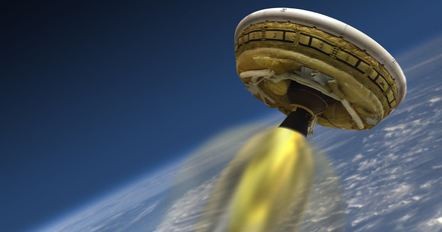Earth to Invade Mars With Flying Saucers
| Arthur Dominic Villasanta | | Jun 03, 2014 07:30 AM EDT |
NASA's flying saucer
It's science fiction but with an interesting twist, or is it spin?
Flying saucers that science fiction fans love will soon be seen in the skies above Earth. No, it won't be a Martian invasion.
Earthmen not aliens will be flying these flying saucers that will ultimately zip through Martian skies.
Like Us on Facebook
NASA is preparing to test a flying saucer-shaped experimental vehicle on the Hawaiian island of Kauai on either June 5, 7, 9, 11 or 14, depending on the weather. The test was originally set for June 3 but was postponed on account of bad weather.
The earthling flying saucer goes by the name "Low Density Supersonic Decelerator" or LDSD.
NASA plans to use its flying saucer to explore Mars. LDSD will make it possible to land heavier spacecraft on the Red Planet.
LDSD's first engineering shakeout flight will be carried live on NASA TV and streamed on the Web.
NASA said LDSD will gather data about landing heavy payloads on Mars and other planetary surfaces. It is preparing for human missions to Mars as part of its "Evolvable Mars Campaign."
Michael Gazarik, NASA associate administrator for Space Technology, said the space agency has two more vehicles in the works for next year.
"We fly, we learn, we fly again," he said.
NASA is testing the LDSD because it has found that accommodating extended stays for explorers on Mars will require larger and heavier spacecraft to ferry astronauts and cargo.
The objective of the LDSD project is to see if the cutting-edge, rocket-powered test vehicle operates as it was designed, in near-space at high Mach numbers.
"After years of imagination, engineering and hard work, we soon will get to see our Keiki o ka honua, our 'boy from Earth,' show us its stuff," said Mark Adler, LDSD project manager.
"The success of this experimental test flight will be measured by the success of the test vehicle to launch and fly its flight profile as advertised. If our flying saucer hits its speed and altitude targets, it will be a great day."
NASA's saucer will be lifted to its test altitude of 120,000 feet by a helium balloon called a Supersonic Inflatable Aerodynamic Decelerator (SIAD). The saucer will then be dropped from SIAD, after which four small rocket motors will fire to spin up and gyroscopically stabilize the saucer.
A half second later, a Star 48B long-nozzle, solid-fueled rocket engine will ignite with 17,500 pounds of thrust, sending the test vehicle to the edge of the stratosphere. The Earth-saucer will make a controlled landing onto the Pacific Ocean off Hawaii some 45 minutes later.
NASA said the goal of the test is to get to an altitude and velocity that simulates the kind of environment one of its vehicles will encounter when it flies in the Martian atmosphere.
TagsFlying saucer, Mars, Dates, NASA, LDSD
©2015 Chinatopix All rights reserved. Do not reproduce without permission
EDITOR'S PICKS
-

Did the Trump administration just announce plans for a trade war with ‘hostile’ China and Russia?
-

US Senate passes Taiwan travel bill slammed by China
-

As Yan Sihong’s family grieves, here are other Chinese students who went missing abroad. Some have never been found
-

Beijing blasts Western critics who ‘smear China’ with the term sharp power
-

China Envoy Seeks to Defuse Tensions With U.S. as a Trade War Brews
-

Singapore's Deputy PM Provides Bitcoin Vote of Confidence Amid China's Blanket Bans
-

China warns investors over risks in overseas virtual currency trading
-

Chinese government most trustworthy: survey
-

Kashima Antlers On Course For Back-To-Back Titles
MOST POPULAR
LATEST NEWS
Zhou Yongkang: China's Former Security Chief Sentenced to Life in Prison

China's former Chief of the Ministry of Public Security, Zhou Yongkang, has been given a life sentence after he was found guilty of abusing his office, bribery and deliberately ... Full Article
TRENDING STORY

China Pork Prices Expected to Stabilize As The Supplies Recover

Elephone P9000 Smartphone is now on Sale on Amazon India

There's a Big Chance Cliffhangers Won't Still Be Resolved When Grey's Anatomy Season 13 Returns

Supreme Court Ruled on Samsung vs Apple Dispute for Patent Infringement

Microsoft Surface Pro 5 Rumors and Release Date: What is the Latest?










